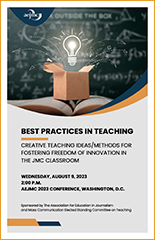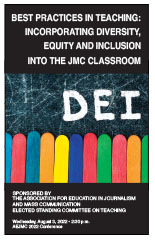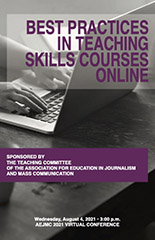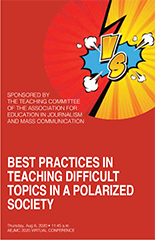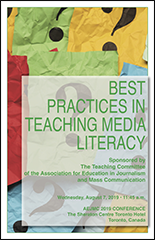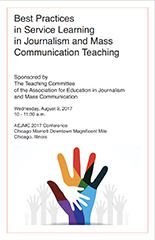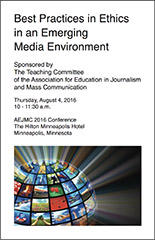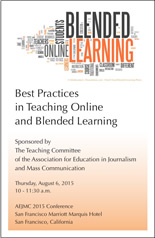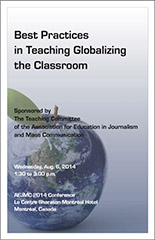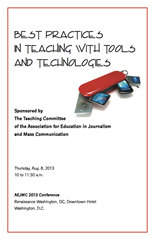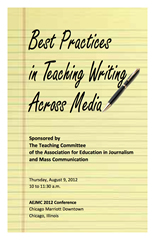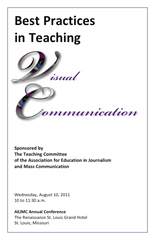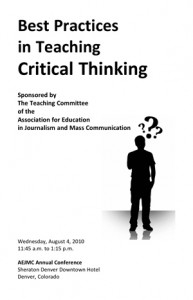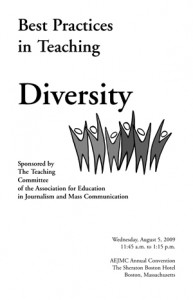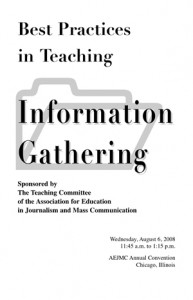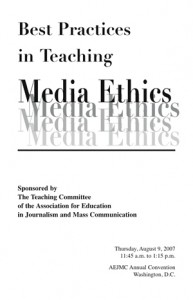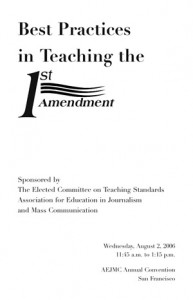Media Ethics 2007 Abstracts
Media Ethics Division
The Trouble With Transparency: The Challenge of Doing Journalism Ethics in a Surveillance Society • David Allen, University of Wisconsin-Milwaukee • This paper argues for a more complex understanding of how the ethic of transparency is used within American journalism. Following the ethical theories of Jürgen Habermas and Michel Foucault, it suggests that transparency has become central to debates about identity formation, disputes over professional jurisdiction, and how journalists have come to cover political events. It calls for the articulation of an ethical framework to justify when transparency is needed.
When is the Truth Not the Truth? Truth Telling and Libel by Implication • Elizabeth Blanks Hindman, Washington State University • Implied libel cases involve defamatory news stories composed entirely of factual, truthful material, which challenges ordinary libel law and ethical norms. This research applies philosophical theories of truth to determine how judges articulate expectations of truth from news media.
Revising journalism ethics through cultural humanism: Lessons from the press coverage in Iraq • Peggy Bowers, Clemson • Previous philosophical viewpoints guiding journalism ethics have become an impediment. Journalism ethics cannot respond to the exigencies of contemporary media practices or the demands of a global community. This paper argues that a framework that more closely reflects the lived human experience can move journalism ethics forward. It offers a preliminary sketch of cultural humanism and then illustrates these features through two case studies from coverage of the Muslim world.
Ethical Guidelines for the Media’s Coverage of Crime Victims • Jack Breslin, Iona College • This study suggests ethical guidelines for the media’s coverage of crime victims utilizing practical and theoretical approaches drawn from several ethical major philosophies. These guidelines should aid journalists in reaching an ethical balance between the needs of the crime victim and the demands of the news media
Universal Principles in Autonomous Systems • Michael Bugeja; Iowa State University • This analysis investigates the existence of universal principles in technological systems. Principles are grounded in space, culture and time, which Internet may obliterate and/or obfuscate. What is the effect of that in a multimedia environment without physical and linear dimensions? Do principles metamorphose in tact in cyberspace (which is no space at all) or do they falter? Discussion focuses on unexplored nuances of theory in virtual environments with recommendations for applications and future study.
The Suffocating Ethicist: A Model of Journalistic Ethical Constraints • Jenn Burleson Mackay, University of Alabama • Journalists are encapsulated by constraining forces that shape their ethical decisions. Individual traits play a significant role in journalistic ethical choices, but additional influences come from the type of media that employ the journalist in addition to organizational, professional, and cultural factors. This paper builds on previous models of structural constraints and proposes a new model of journalistic ethics, which suggests that media that employ journalists act as filters that exert control over ethical decisions.
Forgive Me Now, Fire Me Later: Journalism Students’ Perceptions on Academic and Journalistic Ethics • Mike Conway and Jacob Groshek, Indiana University • Survey data on journalism students’ perceptions of plagiarism and fabulism indicate that students are more concerned about ethical breaches in journalism than in academics. Further analyses found that students near graduation had higher levels of concern and suggested harsher penalties for unethical journalistic behavior, as did students with experience in student media or internships, specifically journalistic ones. Results here demonstrate that applied media experiences and coursework are crucial in developing future journalists’ perceptions of ethical behavior.
Communitarian Theory and Health Journalism: The Feeling is Mutuality • Megan Cox, University of Oklahoma • Health information has become increasingly popular has a news topic. Journalists must decipher complicated information for audiences who may have difficulty understanding the complex news. In this paper, a normative theory such as Communitarianism shows that it may offer some direction in formulating a health story; however, freedom of expression under the First Amendment must be protected over any obligation placed on a journalist.
The Third Person Effect and Reporting Sexual Assault Victims’ Private Information: Applying Mass Communication Theory to an Ethical Dilemma • Erin Coyle, University of North Carolina—Chapel Hill • In the wake of high profile sexual assaults, some journalists claim it is time to reconsider policies that perpetuate the stigma of sexual assault. For decades, most American newspapers have withheld victims’ names, recognizing that naming victims could deepen their devastation and prevent others from reporting the crime. Little empirical research uses mass communication theory to inform the debate. This paper provides a roadmap for research to apply mass communication theory to the ethical dilemma.
The Ethics of Outing in the 21st Century: Two Case Studies • Gary Hicks, Southern Illinois University-Edwardsville and Tien-Tsung Lee, University of Kansas • The past few years have brought media and scholarly attention to a topic once thought passé – the outing of homosexual public figures in the United States. Using framing analysis, this study analyzes the nature of news coverage of both cases. A theory of media ethics is then used to examine the similarities and differences in how the two politicians were outed.
Global Journalism Ethics at the Turn of the 20th Century? Walter Williams in the ‘World Chaotic’ • Hans Ibold, University of Missouri • This paper identifies principles for global journalism ethics in speeches and essays by the early 20th century journalist and founder of the first journalism school, Walter Williams. Williams is not known as a media ethicist, nor is he a major figure in ongoing scholarly work on global journalism ethics. However, his nascent ethical principles offer an important foreshadowing of current discussions on how journalism ethics might work in a global context.
Salience of Stakeholders and Their Attributes in PR and Business News • Soo Jung Moon and Kideuk Hyun, University of Texas at Austin • This study examined which stakeholder groups are salient and whether there has been a change of salience after the Enron collapse. It also investigated which attributes — legitimacy, power and urgency — render certain stakeholders salient based on stakeholder and Corporate Social Responsibility (CSR) theory. Content analyses of press releases from fifty Fortune 500 companies and news stories of The New York Times and The Washington Post found the most frequently mentioned stakeholder was stockholders.
The ethics of the gory details • Kimberly Lauffer, Towson University • Using the framework of care-based social responsibility, this paper examines two news stories that had the potential for the inclusion of graphic details. The two journalists who wrote these stories gathered graphic details in the course of their reporting but differed in their choices to include those details. This paper argues that although multiple factors may have affected these journalists’ decisions, a care-based social responsibility framework evaluates one story as more ethical than the other.
Postconventional Reasoning in Public Relations: A Defining Issues Test of Australian and New Zealand Practitioners • Paul Lieber, University of South Carolina and Colin Higgins, Massey University • This study employed an online version of the Defining Issues Test (DIT) (Rest, 1979) to gather data on the ethical decision-making process patterns of 78, Australian and New Zealand public relations practitioners. Results displayed no statistically significant differences in levels of moral development based on country of origin. Political persuasion, however, proved salient to ethical prediction. Practitioners who self-identified as more liberal reasoned differently about their ethics than right-wing peers.
Serving Two Masters: Reconciling Journalistic Exceptionalism and a Codified Ethical Imperative • Gwyneth Mellinger; Baker University • The founders of the American Society of Newspaper Editors saw themselves as pioneers of newspaper ethics, but during the organization’s early decades, some members struggled to abide by the code the ASNE board had adopted in 1922. This paper examines three case studies in which journalistic exceptionalism, a manifestation of self-interest and blindness to double standards, prevented the ASNE from fulfilling its self-appointed role as standard bearer for journalism ethics.
Stalking the Paparazzi: A View from a Different View • Ray Murray, Oklahoma State University • Because of their pursuit of celebrities, paparazzi have a reputation for doing almost anything to get a photograph. This study examines what ethical standards Los Angeles paparazzi use while searching for a lucrative photograph and what boundaries they draw. The study found longtime paparazzi routinely establish ethical guidelines and are upset with newer paparazzi who do not and have much lower standards; as a result, the newer paparazzi are changing the business.
Dimensions of Journalistic Message Transparency • Chris Roberts, University of South Carolina • The past few years have seen new calls for news organizations to be “more transparent” with the public, but there has been little effort to explicate the construct of transparency. This paper uses the “source-message-channel-receiver” communication model to suggest 11 dimensions of messenger transparency, along an opaque-translucent-transparent continuum for each dimension. The ethical considerations of transparency are discussed.
An Ethical Exploration of Free Expression and the Problem of Hate Speech • Mark Slagle, University of North Carolina • The traditional Western notion of freedom of expression has been criticized in recent years by critical race theorists who argue that this ethos ignores the gross power imbalance between the users of hate speech and their victims. This paper examines the arguments put forth by both the proponents of the classical libertarian model and the critical race theorists and the competing ethical models behind these arguments in an effort to mediate between the two.
Karen Ryan is on the air – the VNR and hegemonic expediency in the newsroom • Burton St. John, Old Dominion University • In 2004, the New York Times broke the story that the Bush Administration had developed and disseminated a video news release (VNR) about the 2003 White House-backed Medicare law. This VNR appeared on more than 40 stations. Subsequent press stories and editorials framed the airing of the Ryan VNR as an unethical communication that violated journalism’s professional standards. This piece explores, from a deontological perspective, how journalists and scholars have articulated those standards.
Recovery in New Orleans and the Times-Picayune: Reviewing the Limits of Objectivity, the Possibilities of Advocacy and the Reform of Public Journalism • N.B. Usher, University of Southern California • Along with the challenges of daily life in post-Katrina New Orleans, journalists at the Times-Picayune face a philosophical dilemma: how can they construct fair and balanced news content in the aftermath of Katrina when virtually everyone has had their lives dramatically changed by the storm? This paper relies on interviews with journalists at the Times-Picayune to explore the ethical dilemmas facing this newsroom—including the limits of objectivity and the need for advocacy journalism.
Media Ethics 2008 Abstracts
Media Ethics Division
The Ethics of Lobbying: Testing an Ethical Framework for Advocacy in Public Relations • Kati Berg, Marquette University • This study evaluates the ethical criteria lobbyists consider in their professional activities using Ruth Edgett’s (2002) model for ethically-desirable public relations advocacy. Data were collected from self-administered surveys of 222 registered lobbyists in Oregon. A factor analysis reduced 18 ethical criteria to seven underlying factors describing lobbyists’ ethical approaches to their work. Results indicate that lobbyists consider the following factors in their day-to-day professional activities: situation, strategy, argument, procedure, nature of lobbying, priority, and accuracy.
Cultivating Critical Thinking in a Media Ethics Classroom • Piotr Bobkowski, University of North Carolina at Chapel Hill • Media ethics instructors and researchers seem to agree that proper ethics education entails the development of critical thinking. But evidence that would support this notion is absent from journalism and mass communication literature. Addressing this deficiency, the present paper identifies the components of critical thinking instruction, evaluates the extent to which decision-making models presented in media ethics textbooks promote critical thinking, and identifies teaching strategies that further critical thinking in a media ethics course.
Documentary Tradition and the Ethics of Michael Moore’s Sicko • Sandra Borden, Western Michigan University • Michael Moore’s documentary, Sicko, is evaluated using virtue theory, which calls our attention to the way traditions inspire us to perform our various roles with moral integrity. Focusing on his use of voice, truth, argument, humor and irony, I will argue that Moore’s performance as a documentary filmmaker generally exhibits coherence, continuity and creativity within the documentary tradition. On the other hand, his performance is not entirely consistent with the moral commitments of documentary filmmakers.
The Moral Sensitivity and Character of Public Relations Students: A Preliminary Study • Mathew Cabot, San José State University • Public relations practitioners and academics have been exploring ethics models, revising ethics codes, holding ethics workshops, and building ethics curricula – all in an attempt to address the ethical lapses that continue to occur in the profession. Little of this activity, however, has included research dealing with the moral development of public relations practitioners and its connection to ethics theories, codes, and instruction.
Ethics of Antismoking PSAs • I-Huei Cheng, University of Alabama; Seow Ting Lee; Jinae Kang, University of Alabama • This study examines the ethical dimensions of public health communication, with a focus on antismoking public service announcements (PSAs). The content analysis of 826 television antismoking ads from the U.S. Center for Disease Control and Prevention’s Media Campaign Resource Center is an empirical testing of Baker and Martinson’s (2001) TARES Test by directly examining the content of tobacco control ads for elements of Truthfulness, Authenticity, Respect, Equity, and Social Responsibility.
Mortality Morality: Effect of Death Thoughts on Journalism Students’ Attitudes Toward Relativism, Idealism, and Ethics • David Cuillier, University of Arizona • This study, based on terror management theory, examines how the thought of death affects views toward relativism, idealism, and unethical behavior. College journalism students (N = 101) participated in an experiment where half were primed to think about death and the other half, the control group, thought about dental pain, and then all of them completed a questionnaire.
Constructing a “Moral Minefield”: News Media Framing of the Ethical Debate in Stem Cell Research • Nicole Smith Dahmen, Manship School of Mass Communication, LSU • The ethical considerations surrounding stem cell research are fueling increasing debate in science, politics, and religion. And this debate has largely been played out in the news media (Nisbet, 2005). This research provides in-depth understanding of how the media have framed the ethical aspects of the stem cell debate. In the analysis of the ethical frames, the theme of the consequences of impeding scientific progress received considerably less coverage than did the religious theme.
There is No Right Answer: What Does Media Ethics Mean to Journalism Students? • Allyson DeVito, University of Tennessee • This study examines the meanings of ethics to journalism students. Although many scholars have argued the importance of teaching media ethics and how best to teach it, there have been few research attempts to examine how journalism students actually understand ethics. After analyzing twelve qualitative interviews, the findings show that students with more professional experience have different meanings of ethics than those with limited experiences outside the classroom, which has implications for teaching media ethics.
Fair Comment? The Ethics of Anonymous Postings on News Web Sites • Kyle Heim, University of Missouri • Many news Web sites now permit readers to post comments on blogs and news stories or to share their thoughts in message forums. Often, readers may do so without having to give their names. Defenders of anonymity say it fosters more candid discussion, but critics charge that it damages trust and encourages incivility. This paper examines the debate and draws on ethical theories to advocate a middle ground of pseudonymity coupled with full-name registration.
The Effectiveness of Newspaper Codes of Ethics • Emily Housley, Texas Christian University • In an industry where public perception appears at an all-time low, it is vital to evaluate the effectiveness of newspaper codes of ethics. Studies have evaluated the role of codes of ethics in the ethical decision-making process, but none have looked at the overall effectiveness of having a code. This study is a quantitative evaluation of one newspaper’s code of ethics, in relation to individuals’ ethical differences, code applicability and code agreement.
The Ethics of Punishing Unethical Expression: Journalism, Imus, and First Amendment Values • Robert L. Kerr, University of Oklahoma • This paper considers the ethics of punishing unethical words — words that not only offend but are argued to cause more harm than simple offense. In this case, the particular words were uttered by radio and television talkshow host Don Imus in 2007. Even though there were no issues implicating First Amendment law in the Imus controversy, strictly speaking, a closer analysis indicates that the relationship between ethical principles and freedom of expression is more symbiotic.
Ethics Research in the New Millennium: A Survey of the Journal of Mass Media Ethics from 2000-2007 • Carol Madere, Southeastern Louisiana University • This article summarizes research published in the Journal of Mass Media Ethics and seeks to determine the most common topic, method of research and theories used. It also evaluates the direction of ethics research against Starck’s prescription for future ethics research after his survey of the journal from 1990-1999. Finally, it proposes future directions for ethics research in the new millennium.
Tragedies of the Broadcast Commons: Consumer Perspectives on the Ethics of Product Placement and Video News Releases • Jay Newell, Iowa State University; Jeffrey Blevins, Iowa State University • Adapting Hardin’s (1968) metaphorical use of “commons” to the domain of broadcasting, we surveyed the attitudes of individuals towards two phenomena (product placement and video news releases), and three constructs (cynicism directed towards government, cynicism directed towards marketers, and the individual’s assessment of their marketing literacy). Respondents were highly cynical about government regulation of advertising and nearly as cynical of the ability of marketer’s to self-regulate.
A Dangerous Deficiency: Why Journalists Have An Ethical Responsibility to Understand the Essentials of Ecology • Bryan H. Nichols, USF • The world is becoming more populated and urbanized, disconnecting people from the natural support systems that maintain their quality of life. This disconnect results in unsustainable policy decisions and lifestyle choices, a situation which journalists are in an ideal position to address. Unfortunately, most journalists are as ecologically illiterate as the public. This paper uses an ethical analysis to argue that all journalists have a responsibility to learn basic ecological principals.
That’s a Wrap (-around!): Blurring the Boundaries of Entertainment and Ads • Kathleen O’Toole, Penn State University • The Children’s Television Act of 1990 restricted the amount of advertising carried on children’s programming and required program separators to distinguish between commercial and non-commercial programming. The law took a “golden mean” approach that balanced the economic imperatives of the television industry with the best interests of young viewers. This paper examines a relatively new genre of programming that may represent an attempt to subvert the spirit and the letter of the law.
“Good Story”—But How Good? Notes Toward a Rhetoric of Journalism • Ivor Shapiro, Ryerson University • Attempts to define how journalists assess their work have consisted of survey research on quality “criteria” and qualitative proposals of “elements” or “principles.” This paper proposes an assessment framework based on the study of rhetoric and organized within five “faculties” (discovery, examination, interpretation, style and presentation). Five standards arise (quality journalism is independent, accurate, open to appraisal, edited and uncensored) plus five criteria of excellence (the best journalism is ambitious, undaunted, contextual, engaging and original).
Academic and Professional Dishonesty: Student View of Cheating in the Classroom and On the Job • Linda Shipley, University of Nebraska-Lincoln • Early studies of academic dishonesty discovered that a large percentage of students admitted they cheated. Since then, additional studies have found even higher numbers of students who report that they cheat, and those students indicate that stress related to getting good grades is a driving factor. Recently, there have been several incidents of journalists who were caught cheating. Could academic and professional dishonesty be connected? This study looks at several factors that might contribute to both.
“Comment Is Free, But Facts Are Sacred”: User-generated content and ethical constructs at the Guardian • Jane B. Singer, University of Central Lancashire/University of Iowa; Ian Ashman, University of Central Lancashire • This case study examines how journalists at Britain’s Guardian newspaper and affiliated website are assessing and incorporating user-generated content in their perceptions and practices. It uses a framework of existentialism to highlight issues of particular interest here, including authenticity and the potentially conflicting ethical constructs of autonomy and responsibility. This study represents one of the first empirical approaches to understanding how journalists are negotiating both personal and social ethics within a digital network.
Video News Release Policies and Usage at Television Stations: Deontological Implications for the Newsroom • Burton St. John, Old Dominion University; Ed Lordan, West Chester University of Pennsylvania • In the last decade, television news stations have received an increasing number of video news releases (VNRs) from PR practitioners who are representing a variety of clients, including government agencies, non-profit organizations and for-profit companies. Despite the increased public profile of the VNR, no research has been conducted on newsroom selection procedures regarding VNRs — specifically, how newsroom VNR policies relate to broadcast journalists’ deontological obligations to multiple audiences.
Twice Victimized: Lessons from the Media Mob at Virginia Tech • Kim Walsh-Childers, University of Florida; Norman Lewis, University of Florida; Jeff Neely, University of Florida • In-depth interviews with survivors, family members and others associated with the April 2007 Virginia Tech shootings revealed that some journalists worsened the trauma through intrusive, insensitive behavior. While some displayed compassion, other journalists knocked on doors at 6 a.m., attempted to sneak hidden cameras into hospital rooms, interrupted grieving students and grabbed a student’s wounded arm.
A Comparison of the Moral Development of Advertising and Journalism Students • Stephanie Yamkovenko, Louisiana State University • This study employed the Defining Issues Test (DIT) to complete the analysis and comparison of the moral development of mass communication students, specifically those who major in advertising and journalism. The DIT is an instrument based on Kohlberg’s moral development theory and is a device for assessing the extent to which a person has developed his or her moral schemas.
How Much Do They Care about Advertising Ethics? -A Content Analysis of Plastic Surgeons’ Websites • Hyunjae (Jay) Yu, Louisiana State University; Tae Hyun Baek, University of Georgia; Yongick Jeong, Louisiana State University; Ilwoo Ju, University of Georgia • The present study focuses on the websites of plastic surgeons who are practicing in the ten major cities of the U.S. Websites are, along with magazine ads, the most popular advertising tool for American plastic surgeons who are now in serious competition among themselves. Under this extremely competitive situation, it is possible that the advertising content could be exaggerating or deceptive to get patients’ attention, as several researchers have indicated.
Media Ethics 2009 Abstracts
Media Ethics Division
Special Call
Teaching journalists how to navigate ethical dilemmas: A case study of ethics in the newsroom • Beth Concepcion, University of South Carolina • The purpose of the media is to cover the issues the public needs and wants to know. However, journalists face competitive and organizational pressures that sometimes conflict with personal morals and principles — and that larger altruistic goal of informing and protecting the public. Often these pressures result in personal and professional ethical struggles.
Standards of Excellence in Breaking News Online: A MacIntyrean Analysis • David Craig, University of Oklahoma • This paper examines the pursuit of excellence in breaking news online and the pressures that stand in the way of it, drawing on interviews with journalists at four large online news organizations. The analysis is guided by MacIntyre’s theoretical framework. Discussion centers on standards of excellence in online journalism, challenges to their attainment, and how journalism as a practice is advancing, declining, or both with developments in online journalism.
Interactive Ethics: Overlapping Norms of Practitioners and the Public in a Shared Media Space • Jane B. Singer, University of Central Lancashire / University of Iowa • Journalists and users share the interactive digital environment in unprecedented ways, suggesting a need to reconsider both professional and audience ethics in this context. This essay considers several ethical principles that take on new configurations for journalists as they move into closer relationships with audiences, then turns to normative concepts that gain relevance for audiences as their online role expands. It concludes by suggesting that digital journalism ethics is an inherently collective enterprise.
The Paradox of Public Interest: Why Serving Private Interests Provides a Stronger Moral Foundation for Public Relations Performed in Behalf of the Public Interest • Megan Stoker, Brigham Young University; Kevin Stoker, Texas Tech University • The paper examines the concept of the public interest as defined in political science literature and public relations research. This paper applies various philosophical approaches from Ayn Rand to Immanuel Kant, along with recent literature on game theory and public and private interests in public relations, to show that the most ethical approach to serving the public interest is focusing on adhering to personal values and private interests.
Student Competition (Carol Burnett Award)
Building credibility: Developing transparency in public relations • Giselle A. Auger, University of Florida • As an industry, public relations struggles with poor public perception. Such perception is strengthened by highly publicized situations involving questionable ethical behavior. The purpose of this paper is to explicate transparency as it relates to public relations, and to discuss the potential for development of trust within organizations and credibility in public relations, through the practice of transparent communication.
Multi-contextual, Visual Ethical Analysis of Privacy and Ritual in Corpse Images from Sichuan Earthquake • Yang Liu, University of Missouri-Columbia School of Journalism • This paper provides a visual-ethical interpretation and analysis of corpse images from the photo coverage of 2008 Sichuan earthquake, China. Corpse images are interpreted in multiple contexts and analyzed around two concepts of privacy and ritual, both of which feature cultural specificity. Through content analysis and interviews, the paper points out the inconsistency of standards and the impact of media benefits in the ethical self-regulation of Chinese photo journalism.
Yes We Can or No Can Do?: The Distortion of News Coverage in Political Ads • Anthony Palmer, University of South Carolina • Barack Obama’s presidential campaign’s use of the Internet in regards to a video advertisement called Bad News created an ethical controversy due to its use of distorted NBC material without consent. This paper addresses the ethicality of Bad News in terms of the ethical perspectives of Immanuel Kant and John Stuart Mill and proposes a solution that would allow future politicians and political organizations to convey the same message without prompting legal or ethical concerns.
Media Morality and Compassion for “Faraway Others” • Ryan Thomas, Edward R. Murrow College of Communication, Washington State University • In January 2009, the BBC refused to broadcast an appeal by the Disaster Emergency Committee (DEC) for humanitarian relief for refugees in the Gaza region on the grounds that it would compromise BBC impartiality. This paper explores three issues highlighted by this incident of concern to media ethics scholars: the blurring of news and non-news discourses, the consequences of impartiality, and the responsibility media institutions have to “faraway others.”
Open Competition Papers
Negotiating Privacy in the 21st Century: The Millennial View • Seth Ashley, University of Missouri School of Journalism; Lee Wilkins, School of Journalism/University of Missouri; Amanda Wysocki, University of Missouri School of Journalism • Traditional philosophical and legal understandings of privacy are not sufficient for appreciating how people think about privacy today. Radin’s “contested commodities” and Westin’s “circles of intimacy” offer a bridge between positive and negative constructions of liberty and privacy.
Journalistic Constraints: Weighing the pressures that surround the modern media • Jenn Burleson Mackay, Virginia Tech • This paper outlines existing models of constraints on journalistic decisions and applies those concepts to journalistic ethics. The researcher considers how journalistic ethics may be influenced by society, the news organization, the profession, technology, and audiences. Survey responses from weekly newspaper, daily newspaper, and television station journalists illustrate how these constraints affect journalists. The researcher suggests that journalists and journalism students should to be aware of these influences in order to make sound ethical choices.
The Ethical Dimensions of Duke’s Communication Response to its Lacrosse Team Scandal • Rod Carveth, University of Hartford; Claire Ferraris, Western Oregon University • Duke University is one of the most elite private universities in the nation, having tied for fifth in the 2005 U.S. News & World Report’s annual college rankings, behind only Ivy League schools. In addition to superior academics, the school boasts several major sport powers, especially its basketball team.
Persistence of Narrative Persuasion in the Face of Deception • John Donahue, University of North Carolina-Chapel Hill; Melanie Green, University of North Carolina-Chapel Hill • Individuals are persuaded by fiction, but left unanswered is whether individuals maintain attitude change when a story presented as factual is later shown to be inaccurate. In this experiment, the alleged truth status of a narrative was manipulated. Participants in two conditions were informed after reading the story it was inaccurate due to (1) unintentional inaccuracy or (2) intentional deception. Although readers derogated a deceptive author, they did not correct their attitudes due to inaccuracies.
Offering the Cloak of Confidentiality to News Sources: Journalist’s Ethical Decision-making Behaviors • Michele Kimball, University of South Alabama • The use of confidential sources in news coverage can provide information integral to understanding significant issues for news consumers, but it comes at a price to journalists’ credibility and ethical standards. This study uses qualitative methods to evaluate journalists’ ethical decision-making behaviors when determining whether to grant sources confidentiality. Results show that journalists engage in a four-part process in determining whether to make a promise to protect a source’s identity.
Facing the Future: Media Ethics, Bioethics, and the World’s First Face Transplant • Marjorie Kruvand, Loyola University Chicago; Bastiaan Vanacker, Loyola University Chicago • When the world’s first face transplant was performed in France in 2005, the complex medical procedure and accompanying worldwide media attention sparked many ethical issues, including how the media covered the story. This study used framing theory to examine what happens when media ethics intersect with bioethics by analyzing French, American, and British media coverage on the transplant and its aftermath.
Television News Coverage and Disaster Management – The Ethical Difficulties of Disaster Journalism • Chao Chen Lin, National Chiao Tung University • The study explores ratings-driven television disaster journalism and other related issues on one side and discusses the relationship between disaster reporting and disaster management on the other. This study uses qualitative research methods such as “case study” and “in depth interview, focuses on the four typhoon disasters occurring between July and September of 2008 and conducts related analysis affecting the news production system of television in Taiwan.
Social Constructivism Meets Social Media: The Case for Collaborative Learning in the Ethics Classroom • Patricia Parsons, Mount Saint Vincent University • Teaching ethics as a collaborative process to cultivate moral imagination is an important adjunct to student development of the knowledge, attitudes and skills required of professional practice. The collaborative nature of the new social media provides a platform for the development of pedagogical approaches that are grounded in social constructivism. This paper presents a case illustration of the application of an online wiki to enhance student engagement in learning about professional ethics.
Short and to the Point: How More Ethical Online Headlines Might Help Restore Journalism’s Reputation • David Remund, University of North Carolina at Chapel Hill • Writing headlines for online media can pose an ethical challenge. The limited real estate and dense saturation on most news organizations’ landing pages means trouble for copy editors and reporters. They must be extremely succinct in their wording yet clever enough to somehow breakthrough the clutter. This paper examines the ethics of news headlines online, drawing upon a blend of primary and secondary research.
Public Relations and Rawls: A Harsh Veil to Wear • Chris Roberts, University of Alabama • John Rawls’ “veil of ignorance” approach to ethical behavior is a seeming staple in mass media ethics textbooks, but the veil is less likely to be given serious consideration as an approach to ethical decision-making than other approaches. This paper looks at the uses, misuses and applications of the veil in contemporary discussions of public relations ethics, and it posits six reasons why the veil may be hard for public relations practitioners to wear.
Beyond Case Studies: An Analysis of Teaching Effectiveness in Award-Winning Media Ethics Exercises • Carol Schwalbe, Arizona State University; David Cuillier, University of Arizona • A content analysis of 228 Great Ideas for Teachers (GIFTs) found that the 16 activities suitable for ethics courses relied on traditional methods of teaching, mainly discussions, teamwork, and case studies. Few used technology, games, or simulations. The authors created an index to measure teaching effectiveness. While most ethics ideas stimulated higher order learning, they did not incorporate other elements that might improve student engagement. The authors make suggestions for dynamic, interactive ethics activities.
Guanxi, Gift-Giving, or Bribery? Ethical Considerations of Paid News in China • Katerina Tsetsura, University of Oklahoma; Zuo Lin, U of Oklahoma • This study of the phenomenon of paid news in China reviews the English-language and Chinese-language literature on the subject of media opacity and cultural traditions of gift-giving and guanxi in Chinese media practices to answer a question whether discussions of media bribery are appropriate in the context of the Chinese media environment.
Credibility as a strategic ritual: The Times, the interrogator, and the duty of naming • Fred Vultee, Wayne State University • This study examines the use of names in the construction of “credibility” as a journalistic duty. Using the framework set forth by Tuchman (1972) of objectivity as a “strategic ritual,” the study discusses the ethical justifications put forth by the New York Times for the process through which it decided to identify a CIA interrogator who had been involved in questioning 9/11 captives.
A Content Analysis of the Public Service Announcements Dealing with Children’s Nutrition and Obesity -Investigating Advertising Appeals, Health Claims, and Health Intervention Techniques- • Jay (Hyunjae) Yu, Louisiana State University; Hoyoung Ahn, U of Tennessee • Public Service Announcements (PSAs) against childhood obesity have been widely used to help children understand the importance of healthy eating habits and smart weight management in their lives. As the rate of childhood obesity in the country has increased enormously in recent years, researchers have emphasized the significant role of the PSAs more than ever, but few have comprehensively investigated the content of the current PSAs dealing with the issues.
Media Ethics Division 2010 Abstracts
Open Competition
Give Me MoMo: Exploring Moral Motivation in Public Relations Students • Mathew Cabot, San Jose State University • Recently, media ethics scholars have begun conducting research using moral development theories and instruments, joining researchers from other fields who have discovered the benefits (theoretical and pedagogical) of integrating moral psychology and moral philosophy in applied professional ethics. This study addresses the question, Why by moral? Using the Four-Component Model of moral functioning, this study examines the moral identities and moral commitments of public relations students from three California universities. Furthermore, it explores the connection between moral identities and professional identities and discusses how these relate to producing moral public relations practitioners.
A Contractarian Approach to Tabloids and the Limits of Celebrity Privacy • Mark Cenite, Nanyang Technological University • Celebrity gossip websites like TMZ have renewed perennial criticisms of tabloids for invading celebrities’ privacy, but this article argues that publication of much standard tabloid fare can be justified through a contractarian ethics approach that examines implied agreements between celebrities and media. Celebrities can be deemed to have assumed risks of relinquishing privacy by thrusting themselves into the limelight. A narrow range of celebrity privacy exists, however, and is violated in cases such as publication of medical information.
A pedagogical proposal on cognitive bias to avoid reportorial bias • Sue Ellen Christian, Western MIchigan University • In this conceptual proposal for an addition to the training of undergraduate students, I suggest that journalists – especially in today’s multicultural, global digital media world — need to be aware of cognitive biases to help avoid reportorial bias that stems from assumptions, stereotypes, norms and thinking processes. This article details an interdisciplinary pedagogical approach and how it has been incorporated into an undergraduate journalism reporting and writing capstone class with generally positive student feedback.
VNRs: Is the News Audience Deceived? • Matthew Broaddus, University of Tennessee; Mark Harmon, University of Tennessee; Kristin Farley Mounts, University of Tennessee • Using a snowball technique, the researchers presented survey respondents with authentic-looking local television news stories. The 132 respondents evaluated three stories. Some used station-generated footage, some network, and some VNRs. Respondents were asked their best estimation of the source. The data indicated a real likelihood VNR deception is occurring. Respondents averaged 56 percent correct identification of VNRs, compared to 65.7 percent for video from affiliated networks, and 82.3 percent correctly identifying locally shot video.
How legalities play a part in the transaction between journalists and their anonymous sources Michele Kimball, University of South Alabama • This research uses qualitative research methods to understand how journalists integrate legal factors into the process by which they determine whether to use unnamed sources in their news reporting. The journalists in this study contended that anonymous sourcing is an ethical issue. Therefore they don’t integrate potential legal ramifications into their ethical choices. But in actuality, many of the journalists’ choices regarding granting anonymity to sources were made with defensive legal strategies in mind.
Non-Western Ethics Analysis of Media Coverage of Death During the 2010 Winter Olympics Mitch Land, University of North Texas; Koji Fuse, University of North Texas; Susan Zavoina, University of North Texas (Associate Professor) • NBC aired a graphic video of the death of a Georgian Olympic luger, Nodar Kumaritashvili, and other U.S. media, including other broadcast networks. The New York Times followed suit. In light of fierce criticisms by the family, viewers and readers, this paper applies utilitarianism, the palaver tree concept, and Confucianism by using the Point-of-Decision Pyramid Model, a modification on the Potter Box, to explore Non-Western paths to moral reasoning in this case.
Personal Ethical Orientations of Journalism Students, Their Association with Tolerance of Others, and Learning Cross-Cultural Principles • Maria Len-Rios, U. of Missouri; Earnest Perry, University of Missouri • A pre-test/post-test study (N=152) gauges the relationship between student personal ethical orientations and the learning of cross-cultural journalism principles. Results reveal those with strong ethical idealism had greater knowledge of conceptual cross-cultural principles at T2 and more strongly believed that they were professionally important. RWA and SDO intolerant personality types were negatively associated with specific ethical orientations. Implications for teaching cross-cultural principles to those with intolerant personalities by incorporating ethical orientations into the course are discussed.
Edgar Snow: How His Early Years in China Illustrate the Importance (and Potential Limitations) of Objectivity • Anthony Moretti, Point Park University • This paper outlines why Edgar Snow concluded objectivity could not serve him as he reported from China in the 1930s and 1940s. Snow dealt with conflicting journalism values as he reported on a nation he came to love. Did his attachment mean he was no longer objective? Yes. This paper examines the ramifications of that question, whether it be answered yes or no.
The Fifth Estate: A textual analysis of how The Daily Show holds the watchdogs accountable Chad Painter, University of MIssouri School of Journalism; Lee Wilkins, University of MIssouri School of Journalism • This study investigates how Jon Stewart and his Daily Show correspondents use laughter to hold the media accountable. By defining accountability and linking it with normative understandings of journalism’s values and institutional role, the study attempts to document whether Stewart is serving as a mirror and critic of individual journalists and the institution of journalism itself. The study also evaluates whether Daily Show content that focuses on news media performance constitutes ethical political communication.
Identifying and Defining Values in Media Codes of Ethics • Chris Roberts, University of Alabama Among other functions, mass media codes of ethics help practitioners identify the values of their individual crafts. This paper uses typologies created by social psychologists to compare values identified in 11 ethics codes for journalists, advertising/marketing practitioners, public relations practitioners, and bloggers. Codes share many similar values types but also show differences based upon the nature of the craft for which the code was designed. Codes also use similar words to describe different values.
A separate code of ethics for online journalism? Results of a large-scale Delphi study Richard van der Wurff, Amsterdam School of Communication Research; Klaus Schoenbach, Amsterdam School of Communication Research & University of Vienna • Sixty experts in a three-wave Delphi study in the Netherlands assess the quality of online and traditional journalism and propose measures for improvement. A small set of commonly accepted journalistic norms, to be observed strictly (like accuracy and transparency), is separated from societal and contextual norms that journalists justifiably can hold different views on (like protecting privacy and separating entertainment from information). Based on these ideas, we propose a voluntary but binding code for journalism in the 21st century.
Ethical Priorities Revisited: A Delphi Study of Furture Ethical Issues facing Journalists Rebecca Tallent, University of Idaho; Michelle Wiest, University of Idaho • The recession of 2009-2010 accelerated many of the economic changes underway for a decade in American journalism, but what about ethical changes? Would smaller newsrooms, media convergence, and citizen journalism have any impact on journalism ethics? This study uses a Delphi technique to define future ethical issues that may result from economic and technical changes in the news media. In addition, the study compares the results with those in a 1995 study that attempted to predict future ethical issues prior to the technological explosion affecting the news industry.
Returning Students’ right to access, choice and notice: A proposed code of ethics for instructors using Turnitin • bastiaan vanacker, loyola university chicago • This paper is an attempt to identify the ethical issues involved with the use of Turnitin by college instructors. The paper first addresses the pros and cons of using plagiarism detection software (PDS) in general and argues that the use of such software in higher education can be justified on the basis that it increases institutional trust while the often cited drawbacks of such software are not universally valid. An analysis of the legal issues surrounding Turnitin will show that the way this particular PDS operates does raise some ethical issues because it denies students notice, access and choice about the treatment of their personal information. The insights of this analysis provide the underpinning for a code of ethics for professors using Turnitin.
The Power of Tank Man versus Neda: How New Media Iconic Images Create Ethical Connections Maggie Patterson, Duquesne University; Virginia Whitehouse, Whitworth University • Iconic images offer insight into new ways ethical connections can be made to battle censorship and indifference. The 1989 Tank Man images following the Tiananmen Square Massacre (6-4 Event), largely unseen inside China, is compared with the 2009 images of Neda Agha Soltan’s shooting death on the streets of Tehran during the Green Revolution, viewed worldwide on YouTube. Social networking and new media may provide ethical relationships that break through homophily.
Public Opinion about News Coverage of Leaders’ Private Lives: A Role for New vs. Old Media? • Bartosz Wojdynski, University of North Carolina at Chapel Hill; Daniel Riffe, University of North Carolina • A Southern state telephone survey (n=416) found agreement that media coverage of public leaders’ private lives is an important news media responsibility, with agreement greater for legacy media than for online media, and differing depending on hypothetical scenarios presented. The data also suggest increasing tolerance of such coverage and growing belief in responsibility of media to report on private indiscretions relative to previous studies
Humiliation TV: A Philosophical Account of Exploitation in Reality Television • Wendy Wyatt, University of St. Thomas • This paper is a philosophical analysis of the frequent charge that reality television is exploitative. It relies primarily on Ruth Sample’s account of exploitation from her 2003 book Exploitation: What it is and Why it’s Wrong to determine, from a theoretically grounded position, whether and in what cases the charge is justifiable. The paper considers the competing values of reality TV and whether the goods that reality TV creates outweigh the harms of its potentially exploitative nature. The paper concludes with a discussion of what action, if any, should be taken in cases where exploitation does occur.
Student Papers – Burnett Competition
The student hypocrite: Exploring the relationship between values and behavior • Giselle A. Auger, University of Florida • Today’s students are tomorrow’s public relations practitioners. Increased demands for transparency and accountability in practice provided relevance for this study that explored the correlation between student values and their behaviors as indicators of how they are likely to perform as practitioners. The purpose of this study was to explore the relationships between student values, based on Kahle’s (1996) List of Values (LOV), the importance students place on ethical standards in public relations practice, and student’s adherence to their university’s honor code. Results of this study indicated a dichotomy between student values and behavior: there was little correlation between student values and their behavior, or between importance of ethical standards and behavior; however, strong correlation was found between student behavior and the perceived behavior of their peers.
Commodification of Community: The Ethics of Lay’s Local • Erica Goodman, University of Colorado at Boulder • The rhetoric of local is increasingly prevalent in food advertising. Using the Lay’s Local campaign, this analysis employs Kidder’s Checklist to determine if advertisements from Frito-Lay are ethical and if they represent and support the objectives of the local food movement. Bok’s understanding of deception, Mill’s utilitarianism and Rand’s rational self-interest all lend to the final conclusion that the misrepresentation used has a short-term focus which does more harm than good and is therefore unethical.
Analyzing Ethics in Newspaper Stories about Capital Punishment • Kenna Griffin, University of Oklahoma • This study analyzed how ethical concepts are reflected in the news media’s coverage of capital punishment through a thematic content analysis of 37 news stories. Although deontological and consequentialist ethical theories were implicitly references throughout the sample, no specific references were made. This suggests the need for more deliberate attention of ethical contexts related to the execution process, as these themes help shape the public’s opinions about historically widely debated legal and social issue.
The Series of Tubes Incident: A Case Study of (Un)Ethical Framing in U.S. Newspapers • Cara Owen, University of Colorado- Boulder • Within today’s changing media environment, today’s newspaper organizations must look out for their own corporate interests in order to survive. For many organizations, meeting the bottom line is not often in the best interest of the citizens. This study gathered data on U.S. newspaper article framing regarding Senator Ted Stevens and the series of tubes incident. Results indicate that 29 percent of the articles merely mocked the Senator without providing political contextualization. The Potter Box model of reasoning was applied to explore justification for such framing. The researcher concluded that pure mockery framing is unethical according to Kant’s categorical imperative, Rawl’s Veil of Ignorance, Aristotle’s Golden Mean and Mill’s Utilitarianism.
Digital Sustainability: Ethical Observations of a Disappearing Present • Ed Peyronnin, Colorado State University • Our consciousness has never been more focused on the present. Key to our future is the record of our past. Repositories rapidly digitize content to improve speed and access. What ethical perspectives guide those who digitize our records? What are the moral duties of those responsible for placing cultural heritages into these repositories? This paper will begin a discussion that communications ethicists should have and provide a definition for the term digital amnesia.
The ethics of public records: Is it always right to publish? • Gwyneth Shaw, University of Arizona School of Journalism • This paper applies the ethical principles outlined by W.D. Ross and Sissela Bok and applies them to two cases involving public records, one involving tapes of jail interviews for Casey Anthony (a suspect in the disappearance of her daughter) and the other concerning a state database of concealed weapons permit holders. This paper asks whether, in today’s information-saturated age, journalists should publish information simply because the law says they may.
Reconsidering Transparency: Finding a Cooriented State in a Disoriented Concept • Ian Storey, Colorado State University • It is time to offer a clear definition of transparency and how it should be considered not only in interpersonal communication practices, but across a vast array of disciplines and professional practices. This paper is an attempt to precisely explicate the concept of transparency, while also offering new theoretical concepts about transparency in light of the influence of new communication technologies. Three states of transparency – including transmissional transparency, transactional transparency, and hypertransparency – are discussed and explicated in this work. The essay also offers initital suggestions of how further research to measure transparency might be found through the coorientation model.
Just (and Unjust) War Journalism ad, in, and post Bellum: Towards a Theory of Comprehensive Conflict Coverage • Philip Todd, University of Oklahoma • Because war is unique among human activities, journalists often lack any paradigm for comprehensive coverage of armed conflict. From the 2001 terrorist attacks, through the subsequent public debate and the eventual military actions in Afghanistan and Iraq, the ongoing discussion often invokes various appropriations of just war theory. This paper examines how this theory itself might serve as a starting point, ongoing rubric and expanded justification for such reportage, and proposes a dozen coverage concerns.
Media Ethics Division Officers
Terms expire October 2010 or later
Click on linked names to contact officers
Head
Jack Breslin
Iona College
Vice Head/Program Chair
Shannon Bowen
Syracuse University
Research Committee Chair
Kati Tusinski Berg
Marquette University
PF&R Committee Chair
Chris Roberts
University of Alabama
Teaching Committee Chair
Jenn Mackay
Virginia Tech
Code of Ethics
The AEJMC Code of Ethics was approved by the membership August 8 during the 2008 AEJMC Chicago Convention.
The Task Force on Ethics was appointed in spring 2004 by incoming president Mary Alice Shaver of Central Florida. The task force was charged to identify core values appropriate to members as well as identify ethical best practices related to training and developing the next generation of researchers and teachers.
Members of the Task Force on Ethics were: Linda Steiner of Maryland (chair), Alan Albarran of North Texas, Beth Barnes of Kentucky, Jay Black of South Florida, Sandra Borden of Western Michigan, Hub Brown of Syracuse, Cliff Christians of Illinois, Ted Glasser of Stanford, Ruth Walden of North Carolina, Dan Shaver of Central Florida and Lorna Veraldi of Florida International.
Best Practices in Teaching
The elected Committee on Teaching Standards presents the “Best Practices in Teaching” series booklets. The booklets are created using the winning entries from the AEJMC Best Practices in Teaching Competition. Booklets are distributed at the Teaching Panel Sessions at past AEJMC Conferences. Click on topics below to view digital booklets (PDFs).
ETHC Current Officers
Serving the Media Ethics Division
for the 2022 – 2023 term
Head
Anita Varma, The University of Texas at Austin
Vice Head/Program Chair
Yayu Feng, University of St. Thomas
Research Chair
Joseph Jones, West Virginia University
PF&R Chair
Kimberly Kelling, Latitude Research
Teaching Chair
Rhema Zlaten, Colorado Mesa University
Web Master
Tom Bivins, University of Oregon
Newsletter Editor
Sorin Nastasia, Southern Illinois University Edwardsville
Entertainment Studies Interest Group
2022 Abstracts
Research Paper • Faculty • Audrey Halverson, Brigham Young University; Kris Boyle, Brigham Young University; Kevin John, Brigham Young University • Battle Royale and Addictive Gaming: The Mediating Role of Player Motivations • Previous research on the prevalence of addictive behaviors among video game players has been varied; however, there are emerging concerns that battle royale games may be particularly conducive to addiction. This study utilizes a survey sample of 536 battle royale players to investigate addiction outcomes for battle royale players and the mediating role of various player motivations.
Research Paper • Student • Seung Woo Chae; Sung Hyun Lee • Sharing Emotion while Spectating Video Game Play • This paper examines how the COVID-19 pandemic associates with Twitch users’ emotion, using natural language processing (NLP). Two comparable sets of text data were collected from Twitch internet relay chats (IRCs): one after the outbreak of the pandemic and another one before that. Positive emotion, negative emotion, and attitude to social interaction were tested by comparing the two text sets via a dictionary-based NLP program. Particularly regarding negative emotion, three negative emotions anger, anxiety, and sadness were measured given the nature of the pandemic. The results show that users’ anger and anxiety significantly increased after the outbreak of the pandemic, while changes in sadness and positive emotion were not statically significant. In terms of attitude to social interaction, users used significantly fewer “social” words after the outbreak of the pandemic than before. These findings were interpreted considering the nature of Twitch as a unique live mixed media platform, and how the COVID-19 pandemic is different from previous crisis events was discussed based on prior literature.
Research Paper • Student • Meredith Collins; Allison Lazard; Ashley Hedrick; Tushar Varma • It’s Nothing Like Cancer: Young Adults with Cancer Reflect on Memorable Entertainment Media • “Entertainment media simulates social experiences, facilitates coping, and develops resiliency in young adults, ages 18 – 39. These outcomes could be beneficial for young adults with cancer, who typically report lacking social support and suboptimal psychological outcomes during and after treatment. Guided by the memorable messages framework, we investigated which entertainment media young adults with cancer found memorable and why. We conducted 25 semi-structured, online interviews. Participants were asked to identify any media title that was memorable or meaningful during their cancer experience; they were also asked to explain whether the title had a positive or negative meaning to them, as well as why they felt that way. Participants were mostly female (79.2%) and White (80%), with a breast cancer diagnosis (45.8%). Media portrayals were helpful if they prompted exploration of emotions and the creation of meaning around the cancer experience, or if they took participants’ minds off cancer. Most entertainment media focused only on death from cancer. Our participants called for more nuanced portrayals that better reflected their lived reality. Our results revealed media are used as social surrogates, and to find affirmation and validation. On the other hand, our participants felt that entertainment media focused too heavily on death. This may contribute to internalized stigma and decrease psychological functioning, or affect the perceptions of cancer-free peers. Our participants called for more nuanced portrayals that depicted the realities of living with cancer. Future research should further probe the effects of entertainment media on psychological outcomes for young adults with cancer.”
Extended Abstract • Faculty • Serena Daalmans, Radboud University, Behavioural Science Institute; Mariska Kleemans; Cedra van Erp, Radboud University Nijmegen, Communication Science; Addy Weijers • All the Reasons Why: Exploring the Relationship between Morally Controversial Content in 13 Reasons Why and Viewers’ Moral Rumination • Via in-depth interviews with young adults (N = 45), we sought to gain deeper insights into the experiences of and reflective thoughts (i.e. moral rumination) about controversial media content. In order to map how moral rumination is incited in viewers, we chose a recent example of controversial television, namely 13 Reasons Why. The results will provide a comprehensive account of moral rumination as a concept, and will thereby further field of positive media psychology.
Research Paper • Student • Stefanie East • A Little Bit Alexis: From Self-Absorbed Socialite to Self-Made Career Woman • The cultural impact of Schitt’s Creek and its eclectic mix of characters has resonated with viewers across the world, partly because of its message of love and acceptance, but also because of the strong female characters. This essay offers an analysis of one the most iconic characters from the show, Alexis Rose. Using Kenneth Burke’s method of pentadic criticism, it will examine the breaking of a stereotype and impact of character development on an audience.
Research Paper • Faculty • Erika Engstrom; Ralph Beliveau, University of Oklahoma • Masculinity’s Representative Anecdote in the MCU: Resistance and Revision in “Avengers: Endgame” • This paper interrogates the 2019 film “Avengers: Endgame” using the lens of hegemonic masculinity. By examining the behaviors and storylines of its central male superheroes, four main themes that challenge hegemonic masculinity were identified: (1) seeking help from and giving help to others, (2) emotional expressiveness, (3) expressions of fear and vulnerability, and (4) emphasis on father-child relationships. These merge to tell an overarching “story”—the representative anecdote—of a progressive and positive masculinity, one that affirms that super-heroic men are not afraid to show vulnerability, uncertainty, and affection. The Marvel Cinematic Universe is one of the largest entertainment franchises in media history, and the positive masculinity presented in this film demonstrates a slow but progressive evolution of gender portrayals that hold the potential for positive representations that reflect the many ways manhood is performed in reality.
Extended Abstract • Faculty • Chris Etheridge, University of Kansas; Fatemeh Shayesteh, University of Kansas; Remington Miller, University of Arkansas at Little Rock; Abigail Carlson, University of Arkansas at Little Rock • From “hunky beefcakes” to “beautiful” Homecoming queens: Perpetrators and victims in true crime podcasts • Because this podcasting platform is still relatively new, few studies have considered how perpetrators of crime and victims of crime have been portrayed. Through a content analysis of true crime podcasts, this study will address a gap in the scholarship by chronicling descriptions of victims and perpetrators in several popular true crime podcasts.
Extended Abstract • Student • Heesoo Jang, University of North Carolina at Chapel Hill; Madhavi Reddi, University of North Carolina at Chapel Hill • [Extended Abstract] Intimacy and Connections: Celebrity Culture in Indian and South Korean Television Shows • This study examined how celebrities’ private lives are used as core elements of Asian television shows. The countries of interest were India and Korea, as the entertainment industries of both countries have increasingly challenged the global dominance of Hollywood. Using qualitative textual analysis, two prominent shows –Taste of Wife (Korea) and Koffee with Karan (India)—were analyzed. Both shows used celebrities’ personal lives and connections to create intimacy with the public and amplify visibility.
Research Paper • Student • Wei Lin • More contributors, shorter continuance? The paradox of entertainment contents contribution • Controversial debates are going on over the issue whether incentive to contribute is to diminish or increase with the expansion of group size. Previous studies on open collaborative platform for knowledge generation and sharing suggest that shrinking group size weakened motivation of contribution. This paper introduces group size into cognitive evaluation theory. By tracing behavior of video contributors in a hedonic information system for 20 months, we illustrate the negative effects of group size of entertainment contributors on intrinsic motivation and social rewards, which lead the discontinuance and inactivity of new contributors. Different mechanisms in hedonic and knowledge-sharing information system are discussed as well.
Research Paper • Student • JINDONG LIU, CUHK; biying wu • A “soul” emerges when AI meets Anime via hologram: a qualitative study on users of new anime-style hologram social robot “Hupo” • Anime-style hologram social robots are the latest entertainment products. This paper discusses how social robots and anime content converge via this new technology. Through interviews (N=18) in the case of Hupo, it identifies unique media phenomena including anime-style gamification and idolization of social robots, anime-assisted interactional order maintenance, and AI empowerment of anime characters. It argues anime fandom practice compensates for inadequate AI incapability, which challenges the vision of realistic human simulation in anthropomorphism.
Research Paper • Faculty • Patrick Osei-Hwere, West Texas A&M University; Enyonam Osei-Hwere, West Texas A&M University; Li Chen, West Texas A&M University • Spotlighting Emotional Intelligence in Children’s Media: Emotional Portrayals in Disney Channel Television Series. • A content analysis of emotions depicted in five Disney channel television series using social cognitive theory, entertainment education, and emotional intelligence constructs, found that characters depicted emotions of happiness, anger, and fear most frequently. There were no significant associations between gender and emotion display. Researchers found significant associations between emotion types and variables of age, emotion labeling, emotion regulation, emotion display target, and emotion display location. Recommendations for media researchers and content creators are discussed.
Research Paper • Student • Suri Pourmodheji, Indiana University, Bloomington • Keeping Up With the Yummy Mummies? Examining Kim Kardashian’s Mediated Yummy Mummy Images on the reality television program Keeping Up With The Kardashians versus Instagram posts. • “This chapter examines concepts of body image and the yummy mummy in motherhood, by analyzing select scenes from the reality television program, Keeping Up With The Kardashians (Keeping Up), and Instagram posts from Kim Kardashian’s personal Instagram page, @kimkardashian. Contextualizing the yummy mummy, the pressures of maintaining the bikini ready body for mothers, exploring body as commodity, and examining a fantasy of motherhood, I apply these concepts to an analysis of Kardashian’s body during her motherhood journey. Furthermore, I argue that Kardashian’s body functions in a hegemonic way as a seemingly attainable goal for postpartum women and those looking to get back into shape post baby. This chapter asks the following questions, how does Kardashian convey the yummy mummy concept referenced by Littler and Jermyn throughout Keeping Up and on Instagram? How does Kardashian function as a persona in flux between her appearance on Keeping Up and on Instagram? Further, how does the in-flux persona play a role in the way she portrays motherhood on Instagram? To address these questions, I use visual and contextual analysis on select scenes and Instagram posts that focus on Kardashian and her body as a mother. From analyzing these examples, I argue for the following conclusions: Kardashian’s role as a mother is portrayed through self-critical language to reinforce an authentic display of the yummy mummy body, through confident Instagram posts depicting her desirable body, and through post-racial visual discourse represented in family pictures on Instagram.
Research Paper • Student • Rachel Son, University of Florida • K-dramas and the American youth: Conceptualizing the aspiration of a youthful utopia • The purpose of the current paper is to develop a model to explain why American youth audiences choose to watch K-dramas. A rationalism approach by deriving concepts from existing theory to identify the variables of the model. The theoretical perspective comes from the theory of Temporarily Expanding the Boundaries of the Self (Slater et al., 2014), as well as contributions from entertainment research regarding enjoyment and affective motivations (Oliver & Raney, 2011). K-drama narratives is the independent variable and youthful utopia aspiration is the proposed dependent variable. As audiences begin temporarily expanding the boundaries of self to restore their identity and attain self-fulfillment, they are transported into the narrative where they identify with the characters’ experience in the stories. This leads to the American youth audiences to learn something about their own identity and life by expanding their understanding about South Korean culture through drama portrayals. In sum, audiences find meaning for their own lives that cannot be gained by self-affirmation through boundary expansion while viewing K-dramas.
Research Paper • Student • Nathan Spencer, The University of Memphis • License to angst: A study of female characters in Christopher Nolan films • This paper is a textual analysis of female characters in Christopher Nolan films. Its purpose is to determine how Nolan represents women in his films, thus adding to the literature on Nolan and on women in blockbuster films. The data consisted of a sample from three of Nolan’s most popular films, The Dark Knight, Inception, and Interstellar. The data was organized into five distinct categories: Dead Wife Syndrome; Women as a plot device for men; Violence as shock value; Mommy issues; and Behind every strong woman is… a man? The results reveal that Nolan’s stories revolve around men, reducing women to stereotyped subordinates. Nolan actively weaponizes his female characters’ femininity, treating them violently in his stories to motivate his male characters and tantalize the audience. His consistent successes over different genres point to moviegoers wanting to consume the stories he tells, regardless of content. This study’s results determine that his influence is directly hindering positive female representation in mainstream blockbuster films.
Research Paper • Faculty • Alec Tefertiller, Baylor University; Lindsey Maxwell, Southern Mississippi • Am I binge-watching or just glued to the couch? Viewing patterns, audience activity, and psychological antecedents for different types of extended-time television viewing • The phenomenon of binge-watching has received considerable attention in both the media and in research. However, extended-time television viewing is not only confined to narrative binges. This study sought to better understand the differences between different types of extended-time television viewing, including binge-watching. While little evidence was found to suggest a connection between problematic mental health antecedents and extended-time viewing, differences in audience attention and overall patterns of consumption were found.
Research Paper • Faculty • Kelsey Whipple, University of Massachusetts Amherst; Ivy Ashe; Lourdes Cueva Chacon, San Diego State University • Aux News: Examining Listeners’ Perceptions of the Journalistic Function of Podcasts • Podcasting is a well-established medium with a rapidly growing audience but no established ethical standards or practices. Through a representative national survey of American internet users (n = 1,025), this research examined how much podcast listeners trust podcasts and how they evaluate their journalistic merit. Podcast listeners trust podcasts less than most other news sources, with the exception of online news and satirical news programs. And though listeners agree that podcasting is a form of journalism, a way to stay informed about news and current events, and a valuable source of information, they are more skeptical of podcasts when comparing them to traditional news sources. Age is the only demographic category that predicts listening frequency.
Research Paper • Faculty • Qingru Xu; Hanyoung Kim; Andrew Billings • Let’s Watch Live Streaming! Exploring Streamer Credibility in Influencing Purchase Intention in Video Game Streamer Marketing • This study aims to examine the effect of streamer credibility on purchase intention in the context of video game streamer marketing, and further explore the underlying mechanism of the examined relationship via a mediation analysis. With recruiting 277 participants in the United State, this study (a) confirms the significant and positive relationship between streamer credibility and purchase intention, and also finds that (b) the mediators of parasocial relationships and streamer loyalty partially mediate the effect of streamer credibility on purchase intention. Surprisingly, the indirect effect of streamer credibility through the two mediators on purchase intention is stronger than the total effect; meanwhile, the direct effect of streamer credibility on purchase intention in the mediation model remains significant but negative. By applying structural equation modeling analysis, the current research offers a theoretical explanation for how streamer credibility influences viewers’ purchase intention in the context of video game streamer marketing, with practical and practical implications outlined.
Extended Abstract • Student • Wenjing Yang; Ruyue Ma • Online and offline : How MOBA games affect adolescence’s Discourse • MOBA games are now a big part of adolescences’ daily life , which not only affect their entertainment but also affect their communication . This paper draws on the theory of scenes proposed by Joshua Meyrowitz (1985) , using the way of participant observation and depth interview . The intial findings are that MOBA games realize the integration of scenarios in three dimensions and thus provided some new discourse for adolescence , which affect their communication and social interaction .
Extended Abstract • Student • Casey Yetter, University of Oklahoma; Alex Eschbach, University of Oklahoma • Earth’s Moralist Heroes: Virtue depictions in the Marvel Cinematic Universe • The purpose of this paper is to identify how virtue ethics are depicted in the Marvel Cinematic Universe (MCU). A thematic analysis was used to analyze 12 of Aristotle’s virtues (courage, temperance, liberality, magnificence, magnanimity, gentleness, truthfulness, wittiness, friendliness, modesty, and righteous indignation) in the protagonist superheroes in the MCU films, the most successful film franchise in cinematic history.
Scholastic Journalism Division
2022 Abstracts
Extended Abstract • Faculty Papers • The Future of the Field: Journalism Degree Motivations, Roles and Relevancy of the Field • Brian J. Bowe, American Univ. in Cairo / Western Washington Univ.; Lucinda Davenport, Michigan State University; Robin Blom, Ball State University • “Journalism students represent the future of the industry. Learning how they conceptualize journalism may build understanding of the field’s evolution. This survey research examines the motivations and perceptions of journalism students about the profession. Preliminary results show that students’ top motivations for pursuing journalism were related to creative reporting skills, continual learning, and travel in their job. They were also interested in current affairs and displayed a modest drive for addressing social injustices.”
Research Paper • Faculty Papers • Student Activism vs. Student Journalism: Racial Justice, Free Speech, and Journalism Ethics in College Newspapers • Jason Shepard • Using two recent controversies involving campus social justice protests and student news organizations, this study uses an interdisciplinary lens to examine free expression and normative journalism ethics discourse. It explores themes related to First Amendment rights and values, journalism ethics, and racial justice, asking which are evident and absent in opinion journalism focused on the cases. It examines universities’ dual missions of supporting free expression and advancing the goals of diversity, equity, and inclusion.
Extended Abstract • Faculty Papers • Extended Abstract: “We’re Playing a Telephone Game”: Understanding How Teenagers Engage with News Through a Simulation • Theresa de los Santos, Pepperdine University; Elizabeth Smith, Pepperdine University; Jillian Johnson, Pepperdine University • With misinformation at an all-time high, this study explores how high school students cope with inaccurate information and perceive journalists through observation of their skills in a breaking news simulation and post-study interviews. Results reveal that young people desire accurate information but lack the tools to correct it and that immersive learning experiences, like the one used in this study, can teach about the role of quality journalism in stopping the spread of false information.
Research Paper • Faculty Papers • The long-term value of networking and diverse professional experience in online communication master’s program cohorts • Shanetta Pendleton, University of North Carolina at Chapel Hill; Rhonda Gibson • A survey of alumni from a 10-year-old cohort-based online master’s program in digital communication showed that respondents felt high levels of sense of community both during the program and after graduation. Respondents reported regular interteraction with cohort members and valued the ability to network with peers from a wide range of communication subfields. Results suggest a cohort structure has strong networking benefits for online master’s students, although more identity-based diversity among cohort members is needed. Universities that currently utilize a cohort structure should more robustly promote this aspect of their programs in marketing and recruitment efforts. They should also take steps to maximize interactions between and among cohorts after graduation to enhance connections with a professionally accomplished base of alumni.
Research Paper • Faculty Papers • Pandemic grading strategies: A natural experiment with audio feedback in an introductory mass communications course • Carolyn Hedges, Syracuse University • The COVID-19 pandemic realities of the Fall 2020 semester provided an opportunity to try integrated technology grading strategies. The natural experiment deployed personalized and generalized feedback to two sections of an introductory mass communications class for their first written assignment. A survey captured students’ perspectives about ‘helpfulness’ and ‘purpose’ of the grading implements. The results indicated that personalized feedback is preferred, and the combination of grading efforts, in general, is helpful.
Extended Abstract • Faculty Papers • The Inconsistency of Journalism Education and Trauma-related Instruction • Joe Hight, University of Central Oklahoma; Elana Newman, University of Tulsa; Ilissa Madrigal; Bret Arnold • Although journalism educators believe trauma topics are important, curricular coverage is inconsistent. This survey examined the extent educators covered specific trauma topics. Participants rated the importance and extent of coverage across four domains in required classes: self-care, trauma-informed interviewing, trauma impact on community, and best community reporting practices. The commonly deemed highly valued topics include ethics of accuracy, sensitivity, respect for survivors, and privacy rights. Self-care was deemed important but often not covered in courses.
Research Paper • Faculty Papers • Teaching Data Science through Storytelling: Improving Undergraduate Data Literacy • You Li, Eastern Michigan U; Ye Wang; Yugyung Lee; Huan Chen, University of Florida; Alexis Nicolle Petri; Teryn Cha • This study notices a significant gap of data literacy between communication students and science students across four U.S. universities. This project develops an experiential teaching and learning platform (OCEL.AI) and proposes a story-centric approach to teach data gathering, analysis, modeling, application, and ethics to students. The results showed that the storytelling approach had significant impacts on students’ knowledge, appreciation, motivation, confidence, and competence in data science, even after controlling the effects of major and gender.
Research Paper • Faculty Papers • Student Journalists Exhibit Different Mindsets, Agree on the Need for Truthful Reporting • Greg Munno, Syracuse University; Megan Craig, Syracuse University; Alex Richards, Syracuse University; Mohammad Ali, Syracuse University • “This study investigates journalism students’ beliefs about the profession they seek to enter. Using Q methodology to explore the participants’ subjective conceptions of journalism, we map their attitudes and beliefs along four dimensions: impartial, neutral, point-of-view, and involved. Participants (n = 54) sorted 28 statements about journalism from “most like” their journalistic mindset to “most unlike.” Factor analysis identified two distinct mindsets among the participants, one expressing a traditional journalistic mindset, the other embracing a more involved, vocal journalism. Yet both factors expressed strong support for many facets of traditional journalism.
Extended Abstract • Faculty Papers • A Systematic Review of Media Literacy Interventions and the Case for Teaching a Logic-Based Debunking Approach • Alexander Sussman; Elia Powers, Towson University • This study uses a systematic review to examine pedagogical approaches used to teach media consumers to debunk falsehoods and evaluate claims. We find that the fact-based “checklist approach” is dominant. This approach, while useful in some contexts, is limited. We make the case for teaching media literacy lessons through a less commonly used logic-based debunking approach in which students ask the question: In what world could this information or claim possibly be true?
Research Paper • Faculty Papers • A mission-based argument for private K-12 student press • Erica Salkin, Whitworth University Department of Communication Studies • While the First Amendment does not guarantee student press within public schools, it does help affirm the value of such opportunities to student communities. Private schools do not enjoy such constitutional support, but may have a more powerful tool closer to home: their own school mission statements. This study analyzes nearly 500 private K-12 school mission statements to determine if the priorities identified by these programs align with the documented benefits of student journalism.
Research Paper • Faculty Papers • An Exploration of and Intervention to Increase Children’s Critical Analysis of News • Sanne Tamboer, Behavioural Science Institute, Radboud University; Anne Vlaanderen; Kirsten Bevelander, Behavioural Science Institute, Radboud University; Radboud Institute for Health Sciences, Radboud University and Medical Centre.; Mariska Kleemans • To take the first steps in increasing children’s critical analysis of fake news, this study (N = 298, 10–12 y/o) looks into children’s fake news knowledge (qualitative) and a theory-based fake news e-learning intervention for children (quantitative). Results show that children do have knowledge on fake news, but that there a large individual differences. The fake news intervention (e-learning) did not increase children’s fake news knowledge and awareness, but it did increase their self-efficacy.
Extended Abstract • Faculty Papers • How to Increase News Literacy via Interventions: Insights from Early Adolescents • Sanne Tamboer, Behavioural Science Institute, Radboud University; Mariska Kleemans; Serena Daalmans, Radboud University, Behavioural Science Institute; Inge Molenaar, Behavioural Science Institute, Radboud University; Tibor Bosse, Behavioural Science Institute, Radboud University • As a first step in the development of news literacy interventions for early adolescents, we discussed with the target group what a successful intervention targeting their own age group’s news literacy should look like. In the focus groups, participants mentioned that it is a challenge to motivate their news literacy, but also discussed intervention elements that they believe can be effective. These are: competition and rewards, tailored content, the accessibility of the intervention, and interactivity.
